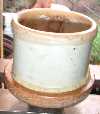


Examples of how to use my welded faceplates - Click on an image to enlarge
Here is a picture of a pile of these faceplates cooling off after being welded

here is a suggestion or two from Ron Alexander with respect to setting up your vacuum system:
My system is up and running; can't wait to get a bowl on it. I
found a couple
of tips you might or might not want to use in your book.
I found an excellent sealing material at Home Depot. Called "Top Mat
Plus",
It is a non-slip pad used to cushion tools in a drawer. It is a soft black
rubber, very flexible, fiber reinforced, 3/16" thickness, compresses well,
and does not slip. It's made by American Non-Slip Products
(www.americannonslip.com). A
17" x 26" pad sells for $5.86.
I used a different idea for a muffler. I mounted a length of pipe insulating
jacket, the type used to prevent freezing, on the outlet. The soft foam
absorbs sound very well.
I look forward to the publication.
Ron Alexander